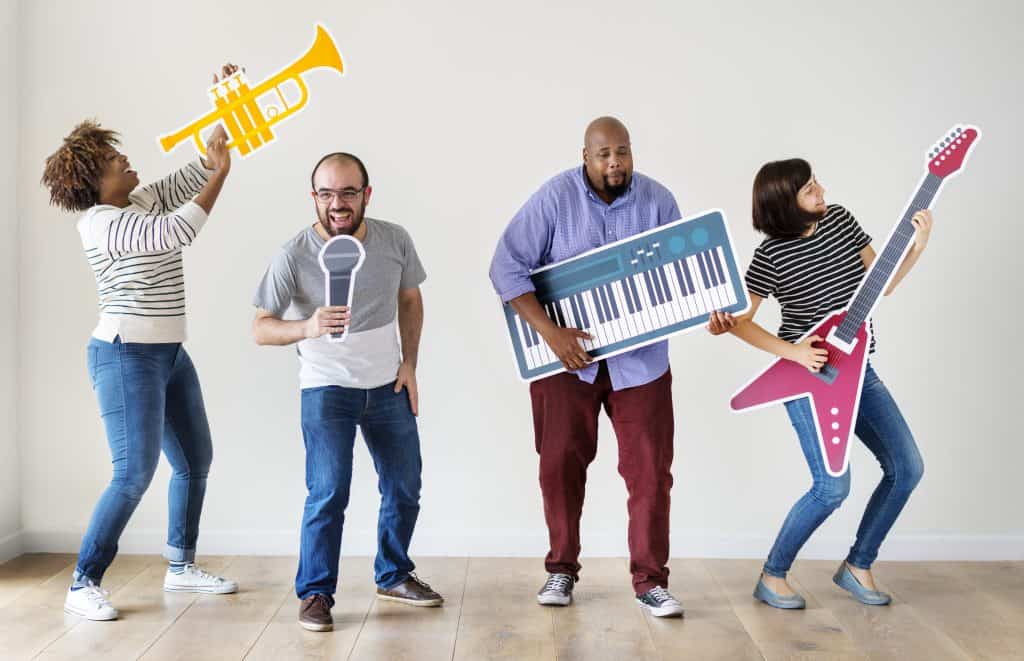As music therapists, we need to learn lots of tools and techniques- both musical and non-musical- to be able to serve our clients and meet their individual needs. One of these tools is musical improvisation, which is music played or sung without previous preparation. For me, the word “improvisation” once filled me with fear and dread- “What do you mean? I have to make stuff up? I can’t read sheet music or a chord chart?”
Yet during my internship, I realized that improvisation was an essential skill I needed in my music therapist toolbox. Over time, I found that musical improvisation can pave the way for high levels of musical, emotional, and self-expression, as well as a social connection with my clients. As I worked on this skill with clients, peers, and supervisors, I realized how important improvisation is to create a space where our clients can thrive.
Improvisation in music therapy can be loosely defined as making spontaneous music with another person, using instruments, voices, movement, and/or play. However, improvisation is not always “play whatever you want, whenever you want”- providing structure and limits to musical interactions with our clients can actually help them shine.
For example, I limit the amount of notes a client can play by giving them a xylophone with 5 bars instead of 12. I also might provide structure by encouraging the client to think of a specific topic to incorporate into their play, such as nature or a certain emotion. These are just two examples, but there are many ways to provide structure while still supporting choice and autonomy.
What Are the Benefits of Improvisation?
Physical: Research has shown that improvisation can improve motor function for patients recovering from neurological damage (Macdonald & Wilson, 2014).
Mental Health: Improvisation can improve symptoms of depression, anxiety, and stress by promoting feelings of positive identity and sense of self, as well as enhanced self-esteem, self-confidence, self-awareness and emotional well-being. Improvisation can also promote freedom from self-critical and judgemental thoughts (Silverman & Baker, 2018).
Communication: Improvisation can encourage communication responses by facilitating nonverbal communication, including body language, eye contact, and social awareness (Beebe, 2021).
Socialization: Improvisation can facilitate social initiation and reciprocity, as well as listening, responding, mirroring, sharing, and turn-taking (McCarren, 2021). It’s also simply a great way to play!
Emotional Wellness: Improvisation can be an avenue for learning about emotions and expressing them. Musical improvisation can complement clients who use alternative styles of communication, as they can express emotions musically instead of verbally (Beebe, 2021). As the saying goes, “When words fail, music speaks!”
Attention: The unpredictable and uncertain nature of improvisation can facilitate a heightened state of awareness and demands a certain level of attention and awareness (Macdonald & Wilson, 2014).
In Art Therapy: While improvisation is not an official term used in art therapy, the concept lends itself to many art therapy techniques that utilize an open-ended directive. Art therapy participants are frequently improvising as they develop their own artistic concepts and explore through shape, line, and color. When this happens, participants may increase confidence, develop insight, and find relaxation, among many other possible benefits. -from Katherine, art therapist at Healing Harmonies
A Final Note
Musical improvisation used to scare me, and I used to avoid it at all costs. Through experiences during my internship and at Healing Harmonies, I’ve gained more experience with improvisation and found a different perspective.
Now, improvisation is important to me because it is creative, engaging, and expressive. Above all, improvisation fosters a musical connection between two people. It is this therapeutic alliance that allows us to work with a client to develop their independence and autonomy. Music connects people, and improvisation is just one of many ways to foster that connection!
References
Beebe, K. (2021). Significant moments in improvisational music therapy: composite case examples of improvisation with adults diagnosed with intellectual and developmental disabilities. Voices, 21(3). https://voices.no/index.php/voices/article/view/3152/3304
Macdonald, R., & Wilson, G. (2014). Musical improvisation and health: a review. Psychology of Well-Being, 4(20). https://doi.org/10.1186/s13612-014-0020-9
McCarren, J. (2021). Outcomes of music therapy improvisation: a scoping review. Master’s Thesis, Western Michigan University. https://scholarworks.wmich.edu/masters_theses/5219
Silverman, M., & Baker, F. (2018). Flow as a mechanism of change in music therapy: applications to clinical practice. Approaches: An Interdisciplinary Journal of Music Therapy, 10(1). http://dx.doi.org/10.56883/aijmt.2018.264
University of Cambridge Autism Research Centre, Cambridge Institute for Music Therapy Research, & Autism- Children’s Improvisational Music Therapy Evaluation. (2023). Improvisational music therapy (IMT) guidelines. https://classic.clinicaltrials.gov/ProvidedDocs/21/NCT06016621/Prot_000.pdf
